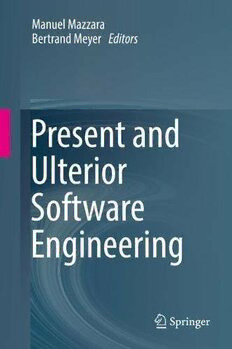
Present and Ulterior Software Engineering PDF
Preview Present and Ulterior Software Engineering
Manuel Mazzara Bertrand Meyer Editors Present and Ulterior Software Engineering Present and Ulterior Software Engineering Manuel Mazzara • Bertrand Meyer Editors Present and Ulterior Software Engineering 123 Editors ManuelMazzara BertrandMeyer InnopolisUniversity ChairofSoftwareEngineering Innopolis,Russia ETHZuRrich ZuRrich,Switzerland ISBN978-3-319-67424-7 ISBN978-3-319-67425-4 (eBook) https://doi.org/10.1007/978-3-319-67425-4 LibraryofCongressControlNumber:2017955568 ©SpringerInternationalPublishingAG2017 Thisworkissubjecttocopyright.AllrightsarereservedbythePublisher,whetherthewholeorpartof thematerialisconcerned,specificallytherightsoftranslation,reprinting,reuseofillustrations,recitation, broadcasting,reproductiononmicrofilmsorinanyotherphysicalway,andtransmissionorinformation storageandretrieval,electronicadaptation,computersoftware,orbysimilarordissimilarmethodology nowknownorhereafterdeveloped. Theuseofgeneraldescriptivenames,registerednames,trademarks,servicemarks,etc.inthispublication doesnotimply,evenintheabsenceofaspecificstatement,thatsuchnamesareexemptfromtherelevant protectivelawsandregulationsandthereforefreeforgeneraluse. Thepublisher,theauthorsandtheeditorsaresafetoassumethattheadviceandinformationinthisbook arebelievedtobetrueandaccurateatthedateofpublication.Neitherthepublishernortheauthorsor theeditorsgiveawarranty,expressorimplied,withrespecttothematerialcontainedhereinorforany errorsoromissionsthatmayhavebeenmade.Thepublisherremainsneutralwithregardtojurisdictional claimsinpublishedmapsandinstitutionalaffiliations. Printedonacid-freepaper ThisSpringerimprintispublishedbySpringerNature TheregisteredcompanyisSpringerInternationalPublishingAG Theregisteredcompanyaddressis:Gewerbestrasse11,6330Cham,Switzerland Preface ThePAUSEsymposiumtookplacefromthe16thtothe19thofDecember2015.It wasthefirstscientificeventintheelegantChâteauofVillebrumier,intheSouthwest of France, newly equippedto serve as a conferencecenter for technicalmeetings, withaparticularfocusoninformationtechnology. TheaimofPAUSEwastomarkthecompletionof14yearsofworkattheChair ofSoftwareEngineeringatETHZurich.Theparticipantswereformermembersof the Chair andcolleaguesfromeverypartofthe worldwho hadthe opportunityto collaboratewithitovertheyears. Inthisinspiringcontext,extensivediscussionsaboutthepast,present,andfuture of software engineering took place between some of the best minds in the field. This volume includes some of the presentationsgiven at Villebrumier, edited and extendedintofullchapters. Thecontentofthisvolumecanbeconsideredaneffectivesynthesisofthecurrent state of the art in software engineering with a projection into the future of the discipline. Innopolis,Russia ManuelMazzara Zürich,Switzerland BertrandMeyer 28April2017 v Contents EngineeringbySoftware:SystemBehavioursasComponents ............. 1 MichaelJackson WhatIsaProcedure?............................................................ 19 EricC.R.Hehner TheEvolutionandEcosystemoftheUnifiedModelingLanguage ......... 37 ClaudeR.Baudoin A Theory of Networking and Its Contributions to Software Engineering ...................................................................... 47 PamelaZave OnLanguageInterfaces......................................................... 65 ThomasDegueule,BenoitCombemale,andJean-MarcJézéquel MoldableToolsforObject-OrientedDevelopment........................... 77 Andrei Chis¸, Tudor Gîrba, Juraj Kubelka, Oscar Nierstrasz, StefanReichhart,andAliakseiSyrel TheChangingFaceofModel-DrivenEngineering........................... 103 RichardF.Paige,AthanasiosZolotas,andDimitrisKolovos BorealisBoundedModelChecker:TheComingofAgeStory.............. 119 MaratAkhin,MikhailBelyaev,andVladimirItsykson HowtoMakeVisualModelingMoreAttractivetoSoftware Developers ........................................................................ 139 AndreyTerekhov,TimofeyBryksin,andYuriiLitvinov IntrinsicRedundancyforReliabilityandBeyond............................ 153 AlbertoGoffi,AlessandraGorla,AndreaMattavelli,andMauroPezzè SoundSimulationandCo-simulationforRobotics........................... 173 AnaCavalcanti,AlvaroMiyazawa,RichardPayne,andJimWoodcock vii viii Contents Microservices:Yesterday,Today,andTomorrow ............................ 195 Nicola Dragoni, Saverio Giallorenzo, Alberto Lluch Lafuente, ManuelMazzara,FabrizioMontesi,RuslanMustafin,andLarisaSafina Microservices:ALanguage-BasedApproach................................. 217 ClaudioGuidi,IvanLanese,ManuelMazzara,andFabrizioMontesi Engineering by Software: System Behaviours as Components MichaelJackson Abstract Software engineering means developing software for a purpose. For systems that interact with a physical problem world, the proximate purpose is a desired behaviour of that problem world: the fundamental engineering task is to develop the system behaviour and specify the software that will evoke it. This chapter sketches a discipline for this task, in which behaviours are always understood as the result of interactions of a software machine and a physical problem world. Complex behaviour is designed in terms of simple constituent behaviours.Therunningbehaviourinstancesformadynamictreeinwhichcontrol ofthetreeisexercisedbythesoftwaremachinesatthenodes. Some salient concepts, principles, practices and concerns of this discipline are discussed. After an introductory section, the development of a simple behaviour is clarified, and the iterative relationship between behaviour and requirements is illustrated. Requirements state the benefits expected from the system behaviour. Anabstractgoalbehaviourisproposed,intendedtosatisfytherequirements.After elaborationintoaconcretebehaviourofthephysicalproblemworld,itisagaineval- uatedagainsttherequirements.Thenatureanddevelopmentofcomplexbehaviour is discussed. Development is partly top-down and partly bottom-up: top-down developmentdecomposesawell-understoodfunctionintosubfunctions;bottom-up development combines disparate functions springing from distinct requirements. In both, the identification and design of constituent behaviours is distinguished fromtheircombinationintoacomplexwhole.Thechapterendswithsomegeneral observationsontheprinciplesembodiedintheapproachdescribed. 1 Introduction 1.1 Two Faces of SoftwareEngineering Wedistinguishtheengineeringof softwarefromengineeringbysoftware.Thefirst looksinwardat the computer,inventing,structuring,elaboratingand transforming M.Jackson((cid:2)) TheOpenUniversity,MiltonKeynes,UK e-mail:[email protected] ©SpringerInternationalPublishingAG2017 1 M.Mazzara,B.Meyer(eds.),PresentandUlteriorSoftwareEngineering, https://doi.org/10.1007/978-3-319-67425-4_1 2 M.Jackson programsforefficientexecutionandcorrectcomputation.Thesecondlooksoutward attheproblemworldwithwhichthecomputerinteracts,specifyingsoftwarewhose executionwillproducedesiredbehavioursinthatworld. If the problem—for example, factorising a large integer or solving a set of equations—is located in an abstract and timeless world, then engineering by softwaremakeslittlesense:inatimelessworld,thecomputercanproducenoeffects andevokenobehaviour.Bycontrast,theworldofaphysicalproblemcanbeaffected and even controlled. Achieving the desired effects and control is an engineering problem:ifitcanbesolvedbyintroducinganappropriatelyprogrammedcomputer into the world, it becomes a problem of engineering by software. This chapter is concerned with problems of this kind. More specifically, it is concerned with the developmentof embedded or cyber-physical systems. These systems have the potentialtobringdramaticbenefitstosociety,butitwillnotbe possibleto realise those benefits—especiallyin critical applications—unlesssoftware becomesmore dependable[1]. 1.2 TheSystem andtheProject Forembeddedorcyber-physicalsoftware,thesystemcomprisesboththesoftware andtheproblemworld—thosepartsofthenatural,engineeredandhumanphysical world—whosebehaviouritmustcontrol. The most important requirements are desired properties and effects of this behaviour. It is a common mistake to identify the requirements with the system behaviouritself. The behaviouritself is the productof a design activity, while the requirementsshouldidentifythebenefitsthatthebehaviourmustbring.Abehaviour cannotbespecifiedexactlybyenumeratingitsintendedbenefits,becausethesame setofbenefitscanbeprovidedbydifferentsystembehaviours.Someorganisations, aimingtostatetheirrequirementsexactly,trytocastthemintheformofstimulus- response pairs, describing the software’s required response to each of the myriad eventsthatmayhappenintheproblemworld.Onecompanyproudlyannouncedat arequirementsworkshopthatacertainproductlinehad200,000requirements.Such anapproachfailsonbothscores:itneitherspecifiesthebehaviourexactly—oreven consistently—norcapturesitsintendedbenefitsexplicitly. Weidentifytheseconceptualpartsofadevelopmentproblem: (cid:129) Themachine:thepartofthesystemexecutingthesoftware (cid:129) Theproblemworld:thephysicalworldmonitoredandcontrolledbythemachine (cid:129) The system behaviour: the behaviour of the problem world resulting from its interactionwiththesoftware (cid:129) The requirements: the benefits that the system behaviour must provide—some directlyobservableintheproblemworldandothersduetomoreremoteeffects andconsequencesofthebehaviour EngineeringbySoftware:SystemBehavioursasComponents 3 Wealsoidentifythesetworolesinadevelopmentproject: (cid:129) Thestakeholders:thepeopleandorganisationswhohavelegitimateinterestsin thesystemandaproperexpectationthatitwillsatisfytheirneedsandpurposes asexpressedintherequirements;somestakeholdersmaythemselvesparticipate inthesystembehaviour. (cid:129) The developers: the software engineers who will design the system behaviour, specifyingthesoftwarethatwillevokeit, andworkingwiththestakeholdersto validatethebehaviour—thatis,toconfirmthattheirexpectationswillbesatisfied. These rolesare merelyconceptual:thestakeholdershaveneeds;thedevelopers designthe system to satisfy them.In practice,the rolesmay overlap,they maybe structuredintomanyspecialisms,andthesamepersonmayplaymorethanonerole. 2 SimpleBehaviour 2.1 A SimpleSystem:ZooVisitor Control Realistic systems have complex behaviours. Complex behaviour emerges from a combination of simple behaviours and the interactions among them. To address complexity, one must have a clear understanding of simplicity. So we begin here withaverysimplesystemwhosepurposeistocontrolvisitorentrytoasmallzoo. ThesystemcanbedepictedinaschematicdiagraminFig.1. Thestripedboxrepresentsthemachine.Theotherboxesrepresentthe problem domains of the problem world. These are the identified relevant components in which the system behaviour will be evoked: the Coin Acceptor, the Barrier, the StopButton,theManagerandtheVisitors.Thelabelledconnectinglinesrepresent interfaces of shared phenomena between system components: at interfaces e and f, the Visitors can operate the Coin Acceptor and the Barrier; at interface d, the ManagercanoperatetheStopButton;atinterfacesa,bandc,themachineinteracts withtheStopButton,CoinAcceptorandBarrier. Fig.1 Asimplesystem
